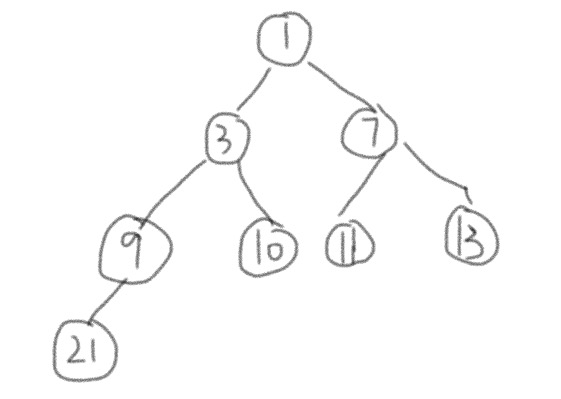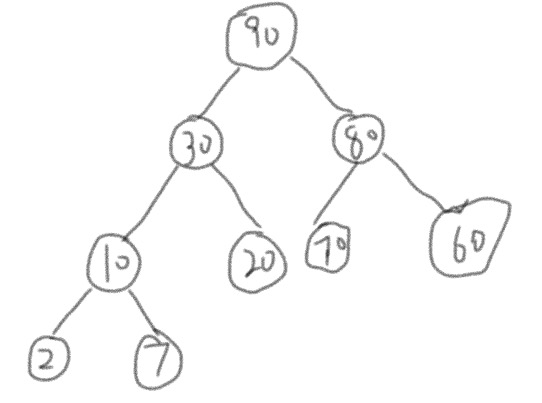/首页
/开源
/关于
数据结构之最大堆和最小堆
发表@2018-09-13 09:15:22
更新@2023-01-21 22:47:40
这个堆并不是堆栈中那个堆,英文我们称之为Heap。堆就是完全二叉树,至于完全二叉树是什么鬼东西,有为青年可能还记得,其余青年可能忘的差不多了,然后自己默默上前面翻去。 堆分为两类,最大堆和最小堆。最大堆就是根结点的元素最大,然后以从上到下从左往右数据递减,最小堆呢就恰恰相反。这里值得注意的是堆的两个特性: - 序号为x的结点,如果有左子树,那么左子树序号一定是2x;如果有右子树,那么右子树序号一定是2x+1 - 序号为x的结点,如果有父结点则其序号为floor( x / 2 )。floor表示不大于x的最大整数 像下面这货,就是典型的最小堆:  最大堆自然就与最小堆相反:  从图中可以观察到的是最大堆的任意一个结点的左右子树(只要存在)都比该结点要小,最小堆的任意一个结点的左右子树(只要存在)都比该结点要大。 那么话说回来,“堆”这玩意到底有啥用?  其实,最大的作用就是堆排序!堆排序是一种不稳定排序,平均时间复杂度为( nlogn ),其中logn是用于构建堆,n用于排序。这种数据结构本身在我们需要top k这种排序的时候会优势比较明显,非常屌,值得掌握。 假如说我们有array( 50, 10, 90, 30, 70, 40, 80, 60, 20 ),然后需要将这个一维数组构建成最大堆,代码大概如下: ```php <?php class Base{ public $fn = null; public $size = 0; public $element = []; public function __construct(){ $this->element[ 0 ] = null; $this->fn = function( $data ){ return $data; }; } } class Max extends Base{ public function __construct(){ parent::__construct(); } // arr 要调整的数组资源 // from 根节点的偏移量 // to 子树的偏移量 // fn 函数 public static function adjust( &$arr, $from, $to, $fn ){ //$tempValue = $fn( $arr[ $from ] ); $rootValue = $arr[ $from ]; // parent 是根节点,parent * 2是左子树, ( parent * 2 ) + 1是右子树 // 对于此处来说,收到的只有父节点而已,根据父节点来判断子节点而并不是直接将子节点当参数传输进来 //echo 'from : '.$from.PHP_EOL; for( $parent = $from; $parent * 2 <= $to; $parent = $child ){ $child = $parent * 2; if( $child < $to && $arr[ $child ] < $arr[ $child + 1 ] ){ $child++; } //echo $parent.' : '.$child.PHP_EOL.PHP_EOL; // 如果根节点比子节点小,那么交换二者数据 if( $rootValue < $arr[ $child ] ){ $temp = $arr[ $parent ]; $arr[ $parent ] = $arr[ $child ]; $arr[ $child ] = $temp; } else { //echo "避免重复比较".PHP_EOL; break; } } } public static function array2max( array $arr ){ $max = new Max(); $max->size = count( $arr ); array_unshift( $arr, null ); //print_r( $arr );exit; // 开始循环数组 for( $i = $max->size; $i > 0; $i-- ){ // 这个循环就是用来 确定每个节点以及其父节点的 $parentIndex = floor( $i / 2 ); if( $parentIndex > 0 ){ //echo $parentIndex.PHP_EOL; self::adjust( $arr, $parentIndex, $max->size, $max->fn ); } } $max->element = $arr; //print_r( $max->element ); return $max; } public function delete(){ $data = $this->element[ 1 ]; $this->element[ 1 ] = $this->element[ $this->size ]; self::adjust( $this->element, 1, $this->size-1, $this->fn ); unset( $this->element[ $this->size ] ); $this->size--; return $data; } public function insert( $data ){ $this->size++; $this->element[ $this->size ] = $data; for( $i = $this->size; $i > 0; $i-- ){ $parentIndex = floor( $i / 2 ); if( $parentIndex > 0 ){ self::adjust( $this->element, $parentIndex, $this->size, $this->fn ); } } } } $max = Max::array2max( array( 50, 10, 90, 30, 70, 40, 80, 60, 20 ) ); print_r( $max->element ); $max->insert( 5 ); print_r( $max->element ); $max->delete(); print_r( $max->element ); ``` 实际上,有为青年可能已经研究到了,php的SPL中已经内置了Heap这种数据结构,我就贴个链接,你们感受一下:[点击这里](http://php.net/manual/en/spl.datastructures.php "点击这里")